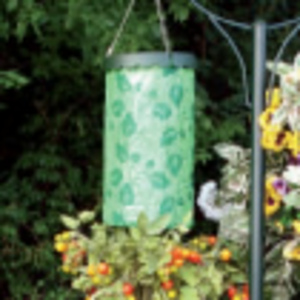The following article contains the author’s personal opinions and observations. Nothing within the contents of the following is to be considered as endorsements, promotions, recommendations, or guarantees by the author, Associated Content.com, Ginnys.com, or any other commercial operation or entity.
*
If you, like me, live in an urban environment you already know how difficult it can be to find enough growing area to make home gardening a worthwhile hobby. Today I would like to propose a partial solution to the problem by introducing what I call my “tomato tree.”
The “tree” is nothing more than two tomato plants, one planted in a pot or some other container in “the old fashioned way,” (which I will hereafter refer to as the “ground plant”), a trellis arising from the ground plant’s container, and a Topsy Turvy® planter (see accompanying photo) hanging directly above, and centered on, the ground plant..
Here’s how I did it.
“Building” the Tomato Tree
The point to keep in mind at all times is that tomatoes, by nature, are climbing plants. In other words, they “want” somewhere to grow and spread. We will exploit this natural trait of the plant to create our trees.
Before “planting” your tree you will need to know how much space you will have available or wish to use. On my deck I’ve placed the hanging planters and the pots with both a plant and trellis at 1½ to 2 foot intervals.
I used a 25 foot roll of 6-foot high plain wire fencing, with enough spacing in the fence material to allow my closed fist to pass through easily, to make my trellises. I cut the roll into sections 3 feet in length and sat each aside until I had a section for each pot (my pots are 1 foot wide. If I multiply by 3, I get the circumference of 3 feet. If you use a different diameter pot, just multiply by 3 to get the proper length of fencing).
With that accomplished, I rolled each section of fencing/trellis until it fit against the narrowest part of the pot. I then added potting soil until the soil lever was about an inch below the lip of the pot. I then transplanted the tomato seedlings.
I then transplanted another seedling to the Topsy Turvy® planter according to the included manufacturer’s instructions. I centered each Topsy Turvy® directly over the base plant and trellis and suspended it from a heavy duty decorative wood screw.
After that, it’s just a matter of tending to the plants and letting the two plants grow toward each other. You now have a “tomato tree!”
Advantages
I transplanted my seedlings during the first week of May and now, at mid June, the base and top plants have already grown together to the point that they are beginning to make good shade “trees” in the afternoon.
Although I used only Beefsteak tomatoes if you were to use different varieties of plants, their closeness to one another would almost certainly lead to cross-pollination which could result in some interesting hybrids.
Finally, perhaps the most appealing part of having these “trees” is the knowledge that I have doubled my growing area without doubling the growing space! Plus, I have the potential to double my tomato output within the same space as before! If you’re a gardener, rural or urban, it’s hard to find a better use of space than “tomato trees.”
Good luck and have happy, and fun, gardening.
*
The above article contains the author’s personal opinions and observations. Nothing within the contents of the above is to be considered as endorsements, promotions, recommendations, or guarantees by the author, Associated Content.com, Ginnys.com, or any other commercial operation or entity.


